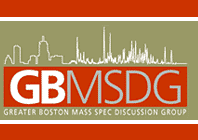GBMSDG Meeting Archives
February 25, 2010
Guest Speaker
John Asara, Ph.D.
Assistant Professor of Medicine
Harvard Medical School
Director, Mass Spectrometry Core
Beth Israel Deaconess Medical Center
Proteomics in the Cretaceous
Location
Acceleron Pharma
149 Sidney Street, Cambridge
Sponsored by
Acceleron Pharma
Special thanks to Acceleron for sponsoring and hosting this event. It is the active participation of our sponsors that allows us to keep the fees for membership, dinners, drinks, speakers, etc. so low.
Presentation Abstract
Studying proteins in signaling pathways from cancer tissue by mass spectrometry requires fine tuned sample preparation techniques coupled with very high sensitivity for success. Interestingly, the same requirements are necessary to study protein remnants from exceptionally well-preserved multi-million year old fossil bones. While much is known about the history of ancient organisms based entirely on the fossil record, molecular data from these fossils has not been interrogated until recently. This comes at a time when state-of-the-art mass spectrometry is sensitive enough to gain some insight into the past. While we cannot interrogate the proteomes of ancient organisms such as dinosaurs and mammoths to get functional information as we can for modern organisms, we can learn about their evolutionary origins on the molecular level by studying preserved fossil bone proteins such as collagen. Our lab has been working to acquire peptide sequences from ancient year old fossil bones to create an evolutionary tree of life based solely on protein sequence data. Initial mass spectrometry sequencing results from our work on an exceptionally well-preserved 68 million year old Tyrannosaurus rex fossil and more recently a 80 million year old Hadrosaur fossil using microcapillary LC/MS/MS with ion trap and orbitrap instruments have yielded collagen sequences that while short, contain phylogenetic signature to accurately place these organisms in evolution near birds when compared to collagen sequences from than 21 modern organisms. I will show the journey through these analyses including both the technical difficulties in addition to the controversial aspects and the subsequent statistical and phylogenetics analyses. Recently, we have focused our efforts on Miocene era bone to bridge the gap between Pleistocene mastodon fossils and the Cretaceous dinosaur fossils.
